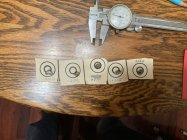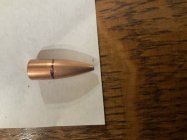Accuracy is relative to the task at hand.
If you are shooting Ground Hogs out past 500 yards, you obviously need a more accurate rifle than if you are shooting at a White Tail at 100. But that Ground Hog Rifle might not be suitable to take a White Tail.
If you are talking competitive shooting, a bullet that is “accurate” out past 600 yards might be totally useless in a Short Range Benchrest Match, and visa-versa.
In short range, we sacrifice all aspects of of ballistic performance toward the combinations ability to stack one bullet atop the other at 100/200/300 yards. Often the bullets and combination we shoot defy the norm, especially in the 30 caliber realm in weights of 112 to 115 grains. They are short and stubby. But one thing most of the better ones have is a nice long shank in relation to the diameter and the overall length.
As an example, my 112 30 caliber is still .308 clear out to the mark. That is pretty long, longer than the diameter of the shank.
Bullets such as this are some of the most accurate bullets made when shot out of a 1-17 or 1-18 twist barrel at 200/200/300 yards.
I believe the true test of any concept is the aggregate. One five shot group is not very informative. Even two or three can still leave doubts. In a rifle destined for competition, you need to shoot it as many times as required in the aggregate. That would usually be five.
I did a serious test of a new Bartlien 30 caliber 1-18 400 mod barrel last week, and I had to account for every shot. No give always. This takes some serious concentration. Shooting my own 112, you can see how capable these short 30’s are at 100 yards in five 5-shot groups.
View attachment 1497580
View attachment 1497571













